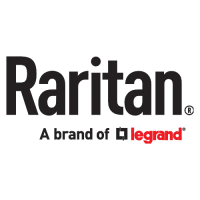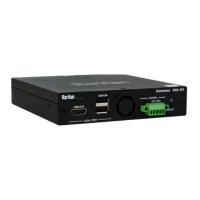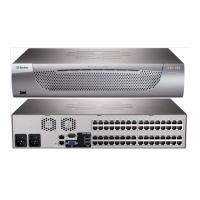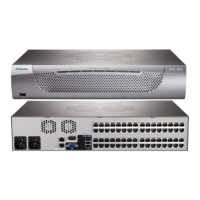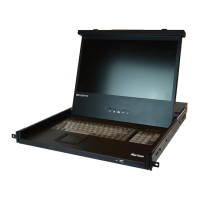
Do you have a question about the Raritan Dominion LX and is the answer not in the manual?
| Model | Dominion LX |
|---|---|
| Local Console | Yes |
| Power over Ethernet | No |
| Power Consumption | Varies by model |
| Weight | Varies by model |
| Network Interface | 10/100/1000 Mbps |
| Form Factor | 1U |
| Protocols | TCP/IP, HTTP, HTTPS |
| Authentication | LDAP, RADIUS, Active Directory |
| Management | Web-based, Command Line Interface (CLI) |
| Operating Temperature | 0°C to 40°C (32 to 122°F) |
| Category | KVM over IP Switch |
| Ports | 8 |
| Jumbo Frame Support | No |
| Quality of Service (QoS) | No |
| Security Features | Encryption |
| Humidity | 10% to 90% non-condensing |
Provides an overview of the LX KVM-over-IP switches, highlighting features for SMBs.
Showcases images of the Dominion LX-108 model, detailing its front and back panels.
Lists the items included with each LX device shipment, such as the LX device, rackmount kit, and power cord.
Details client applications compatible with LX, including MPC, RRC, VKC, RSC, and AKC, and their requirements.
Describes the integrated features of the LX KVM-over-IP switches, including server port models, user capacity, and connectivity.
Outlines software features such as virtual media support, port scanning, mouse synchronization, and security encryption.
Explains how to access and use the LX online help, including installation, configuration, and troubleshooting information.
Provides links to related documentation like the LX Quick Setup Guide and KVM and Serial Access Clients Guide.
Defines key terms and components used in the LX manual, illustrated with a diagram of typical LX setup.
Provides a brief overview of the LX installation and configuration process, outlining key steps.
Details the default administrative credentials (username, password) and IP address for the LX device.
Guides users through the initial setup and configuration of the LX, covering target servers and firewall settings.
Explains the different interfaces available for the LX, including local and remote console access.
Details the LX local console interface and how to manage LX devices connected to it.
Describes the LX remote console interface, including launching, navigation, and port scanning features.
Covers the process of scanning ports on target servers using the LX, including managing favorites.
Explains how to manage favorite target servers within the LX interface for easier access.
Provides instructions on how to properly log out of the LX session.
Details how to configure proxy server settings for specific client applications like MPC, VKC, and AKC.
Introduces VKC and AKC clients, discussing their features and usage with the LX.
Provides detailed information about the Virtual KVM Client (VKC) functionality and its use.
Explains the capabilities and usage of the Active KVM Client (AKC) in conjunction with the LX.
Describes the functions and elements of the LX toolbar for user interface navigation.
Details the configurable properties related to establishing connections to target servers via the LX.
Provides information on connection status and details for target servers managed by the LX.
Covers various keyboard settings and options available for configuring the LX and target servers.
Explains the video settings and properties that can be configured for the LX and target server connections.
Details the mouse settings and options for configuring pointer behavior and synchronization in the LX.
Describes the various tool options and functionalities available within the LX interface.
Explains the view options for customizing the display and layout within the LX interface.
Details the available help options and resources for using the LX.
Introduces the Multi-Platform Client (MPC) for accessing LX and describes how to launch it.
Provides instructions on how to launch the MPC client from a web browser interface.
Introduces the Virtual Media feature, explaining its purpose and capabilities for remote server management.
Lists the necessary requirements and conditions for successfully using the Virtual Media feature.
Explains how to use Virtual Media specifically within a Linux operating system environment.
Discusses scenarios where Virtual Media read/write functionality may not be available and potential causes.
Provides step-by-step instructions and guidance on how to use the Virtual Media feature effectively.
Details the setup process for a file server to host ISO images for Virtual Media.
Guides users on how to establish a connection using the Virtual Media feature.
Explains the proper procedure for disconnecting from a Virtual Media session.
Covers the management of user groups, including listing, relationships, and adding/modifying groups.
Details user management, including user lists, adding/modifying users, and logging users off.
Explains various authentication methods supported by the LX, such as LDAP, RADIUS, and internal authentication.
Provides instructions on how to change the user password for the LX.
Covers configuration of network settings for the LX, including basic and LAN interface settings.
Details various device services such as enabling SSH, configuring ports, and discovery port settings.
Discusses overall security settings for the LX, including login limitations and strong passwords.
Explains how to configure limitations for user logins to enhance security.
Provides guidelines and requirements for setting strong, secure passwords for LX users.
Details the functionality for blocking user accounts to prevent unauthorized access.
Covers encryption methods and sharing configurations to secure LX data and access.
Explains the management and configuration of SSL certificates for secure LX connections.
Describes the audit log feature, which records system events and user activities for monitoring.
Explains how to view and retrieve device information for the LX.
Details the procedures for backing up and restoring LX configuration and data.
Provides instructions for upgrading CIMs (Computer Interface Modules) used with the LX.
Guides users through the process of upgrading the LX firmware to the latest version.
Lists the history of firmware upgrades performed on the LX device.
Explains how to reboot the LX device, including the procedure and considerations.
Describes the network interface page for diagnosing network connectivity issues.
Explains how to view network statistics to monitor and diagnose network performance.
Details the ping host functionality for testing network reachability to target devices.
Explains how to use the trace route tool to diagnose network path issues.
Covers general device diagnostic tools and procedures for troubleshooting the LX.
Provides an introduction to the Command Line Interface (CLI) for managing the LX.
Details how to access the LX device using the Command Line Interface (CLI).
Explains how to establish an SSH connection to the LX for command-line access.
Covers commands for administering the LX console server configuration.
Details commands for configuring network settings via the LX CLI.
Introduces the LX Local Console feature and its capabilities for direct server access.
Discusses the handling of simultaneous user access to the LX Local Console.
Explains the LX Local Console interface and its interaction with LX devices.
Covers security and authentication aspects related to the LX Local Console.
Lists the supported video resolutions for the LX Local Console.
Describes the port access page for the Local Console server display.
Guides users on how to access a target server using the LX Local Console.
Explains how to scan ports using the LX Local Console.
Details the various scan options available within the LX Local Console.
Explains the use of hot keys and connect keys for controlling target servers via the LX Local Console.
Provides examples of connect key combinations for specific operations.
Details special key combinations for Sun systems when using the LX Local Console.
Explains how to return to the main LX Local Console interface.
Covers the administration of local ports connected to the LX.
Details how to configure local port settings for the LX Local Console.
Explains how to perform a factory reset on the LX Local Console.
Provides instructions on how to reset the LX device using the physical reset button.
Lists the detailed technical specifications for the LX KVM-over-IP switches.
Describes the function of various LED indicators on the LX device.
Lists the operating systems supported for client access to the LX.
Details the web browsers that are compatible with the LX interface.
Lists supported CIMs and the operating systems they are compatible with for LX use.
Lists the video resolutions supported by the LX.
Discusses the impact of connection distance on video resolution for target servers.
Explains how to retrieve user group information from LDAP/LDAPS and Active Directory.
Details how to modify registry settings to allow write operations to the LDAP schema.
Provides steps for creating a new attribute within the LDAP schema.
Explains how to add attributes to existing classes in the LDAP schema.
Details the process for updating the LDAP schema cache.
Guides on editing rciusergroup attributes for user members in LDAP.
Provides an overview of various informational notes and topics related to the LX.
Discusses the Java Runtime Environment (JRE) and its relevance to LX functionality.
Contains notes and information regarding IPv6 support for the LX.
Provides information related to keyboard support and configurations for the LX.
Includes notes on using Fedora with the LX, covering focus and mouse synchronization.
Discusses video modes and resolutions, including issues with display and specific hardware.
Contains informational notes about Virtual Media usage, including client environments and connection issues.
Provides informational notes about CIMs, including Windows and Linux compatibility.
Presents frequently asked questions and their answers related to the LX device.


